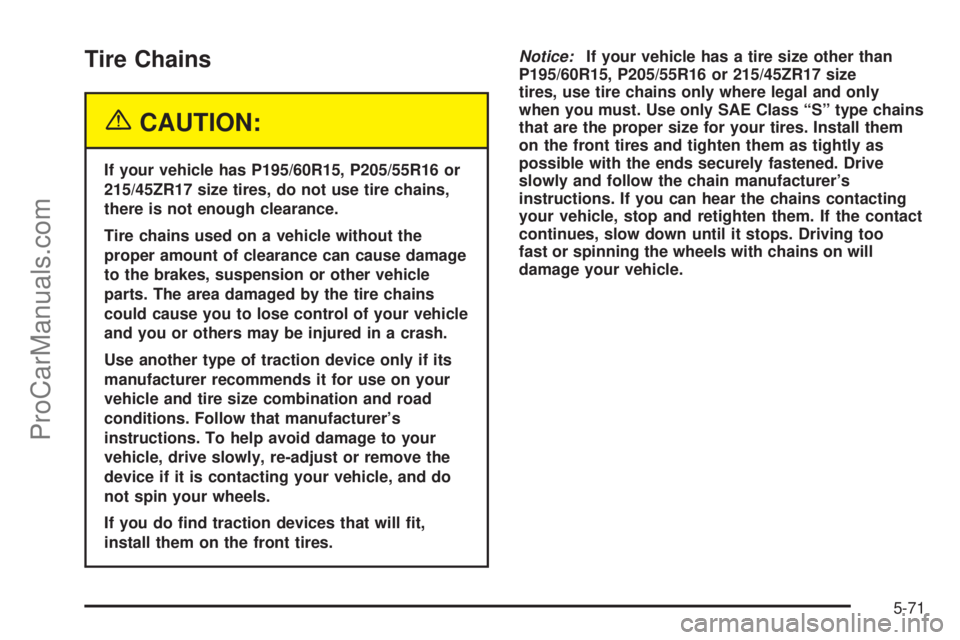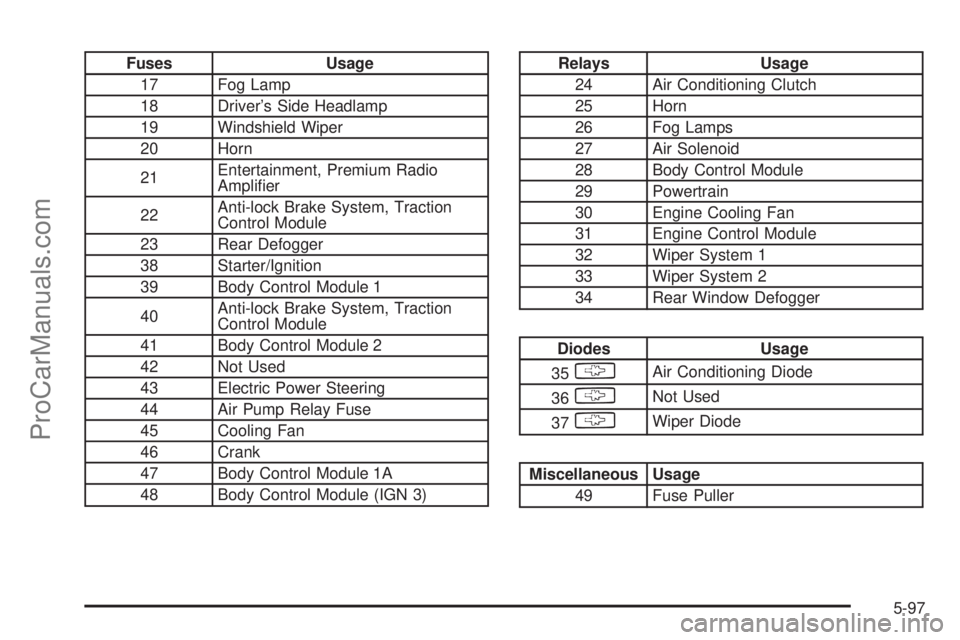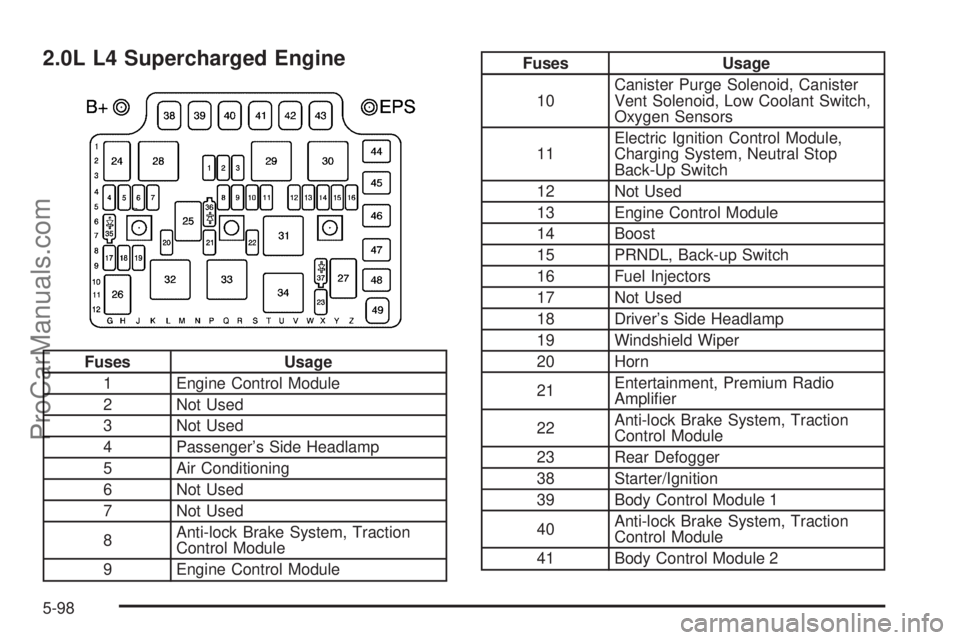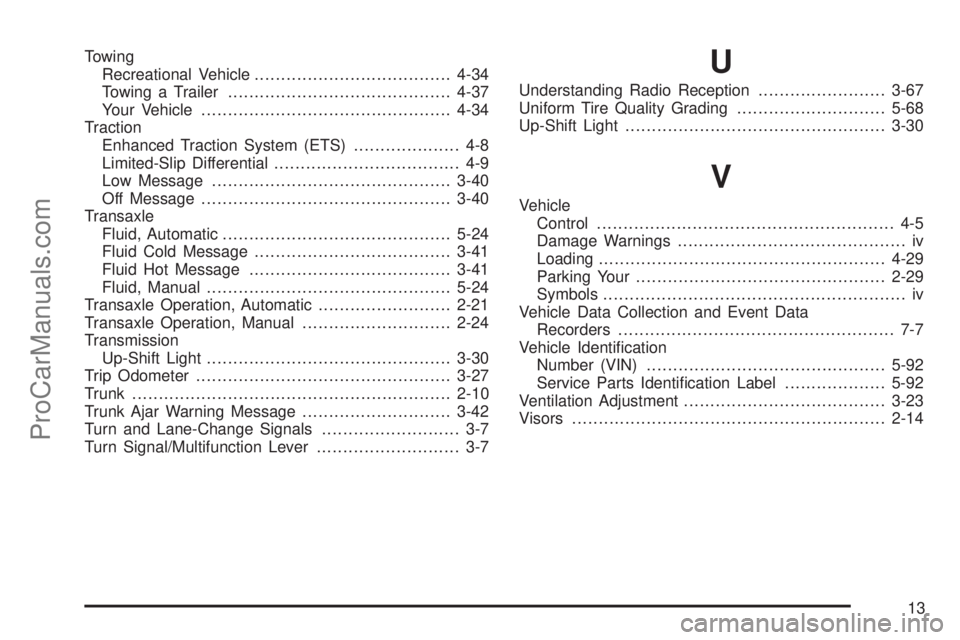traction control SATURN ION 2005 User Guide
[x] Cancel search | Manufacturer: SATURN, Model Year: 2005, Model line: ION, Model: SATURN ION 2005Pages: 366, PDF Size: 2.74 MB
Page 190 of 366

Skidding
In a skid, a driver can lose control of the vehicle.
Defensive drivers avoid most skids by taking reasonable
care suited to existing conditions, and by not overdriving
those conditions. But skids are always possible.
The three types of skids correspond to your vehicle’s
three control systems. In the braking skid, your wheels
are not rolling. In the steering or cornering skid, too
much speed or steering in a curve causes tires to slip
and lose cornering force. And in the acceleration
skid, too much throttle causes the driving wheels
to spin.
A cornering skid is best handled by easing your foot off
the accelerator pedal.
If you have the Enhanced Traction System (ETS),
remember: It helps to avoid only the acceleration skid.
SeeEnhanced Traction System (ETS) on page 4-8.
If you do not have the Enhanced Traction System,
or if the system is off, then an acceleration skid is
also best handled by easing your foot off the
accelerator pedal.
If your vehicle starts to slide, ease your foot off the
accelerator pedal and quickly steer the way you want
the vehicle to go. If you start steering quickly enough,
your vehicle may straighten out. Always be ready
for a second skid if it occurs.Of course, traction is reduced when water, snow, ice,
gravel, or other material is on the road. For safety, you
will want to slow down and adjust your driving to
these conditions. It is important to slow down on slippery
surfaces because stopping distance will be longer and
vehicle control more limited.
While driving on a surface with reduced traction, try
your best to avoid sudden steering, acceleration,
or braking, including engine braking by shifting to a
lower gear. Any sudden changes could cause the tires
to slide. You may not realize the surface is slippery
until your vehicle is skidding. Learn to recognize warning
clues — such as enough water, ice, or packed snow
on the road to make a mirrored surface — and
slow down when you have any doubt.
If you have the anti-lock braking system (ABS),
remember: It helps avoid only the braking skid. If you do
not have ABS, then in a braking skid, where the
wheels are no longer rolling, release enough pressure
on the brakes to get the wheels rolling again. This
restores steering control. Push the brake pedal down
steadily when you have to stop suddenly. As long as the
wheels are rolling, you will have steering control.
4-14
ProCarManuals.com
Page 205 of 366

Rocking Your Vehicle to Get It Out
First, turn your steering wheel left and right. That
will clear the area around your front wheels. If your
vehicle has the enhanced traction system (ETS), you
should turn the ETS off. SeeEnhanced Traction
System (ETS) on page 4-8. Then shift back and forth
between REVERSE (R) and a forward gear, or with
a manual transaxle, between FIRST (1) or SECOND (2)
and REVERSE (R), spinning the wheels as little as
possible. Release the accelerator pedal while you shift,
and press lightly on the accelerator pedal when the
transaxle is in gear. By slowly spinning your wheels in
the forward and reverse directions, you will cause a
rocking motion that may free your vehicle. If that does
not get you out after a few tries, you may need to
be towed out. If you do need to be towed out, see
Towing Your Vehicle on page 4-34.
Loading Your Vehicle
It is very important to know how much weight your
vehicle can carry. Two labels on your vehicle show
how much weight it may properly carry, the Tire
and Loading Information label and the Vehicle
Certi�cation label.
{CAUTION:
Do not load your vehicle any heavier than the
Gross Vehicle Weight Rating (GVWR), or either
the maximum front or rear Gross Axle Weight
Rating (GAWR). If you do, parts on your
vehicle can break, and it can change the way
your vehicle handles. These could cause you
to lose control and crash. Also, overloading
can shorten the life of your vehicle.
4-29
ProCarManuals.com
Page 287 of 366

Buying New Tires
To �nd out what kind and size of tires your vehicle
needs, look at the tire and loading information label. For
more information about this label and its location on
your vehicle, seeLoading Your Vehicle on page 4-29.
The tires installed on your vehicle when it was new had a
Tire Performance Criteria Speci�cation (TPC Spec)
number on each tire’s sidewall. When you get new tires,
GM recommends that you get tires with that same TPC
Spec number. That way your vehicle will continue to have
tires that are designed to give proper endurance,
handling, speed rating, load range, traction, ride and
other things during normal service on your vehicle. If your
tires have an all-season tread design, the TPC number
will be followed by an “MS” (for mud and snow).
If you ever replace your tires with those not having a
TPC Spec number, make sure they are the same
size, load range, speed rating and construction type
(bias, bias-belted or radial) as your original tires.{CAUTION:
Mixing tires could cause you to lose control
while driving. If you mix tires of different sizes,
brands, or types (radial and bias-belted tires),
the vehicle may not handle properly, and you
could have a crash. Using tires of different
sizes, brands, or types may also cause
damage to your vehicle. Be sure to use the
correct size, brand, and type of tires on all
wheels. It is all right to drive with your
compact spare temporarily, as it was
developed for use on your vehicle. See
Compact Spare Tire on page 5-83.
{CAUTION:
If you use bias-ply tires on your vehicle, the
wheel rim �anges could develop cracks after
many miles of driving. A tire and/or wheel
could fail suddenly, causing a crash. Use only
radial-ply tires with the wheels on your vehicle.
5-67
ProCarManuals.com
Page 288 of 366

Uniform Tire Quality Grading
Quality grades can be found where applicable on the
tire sidewall between tread shoulder and maximum
section width. For example:
Treadwear 200 Traction AA Temperature A
The following information relates to the system
developed by the United States National Highway
Traffic Safety Administration, which grades tires by
treadwear, traction and temperature performance.
(This applies only to vehicles sold in the United States.)
The grades are molded on the sidewalls of most
passenger car tires. The Uniform Tire Quality Grading
system does not apply to deep tread, winter-type
snow tires, space-saver or temporary use spare tires,
tires with nominal rim diameters of 10 to 12 inches
(25 to 30 cm), or to some limited-production tires.
While the tires available on General Motors passenger
cars and light trucks may vary with respect to these
grades, they must also conform to federal safety
requirements and additional General Motors Tire
Performance Criteria (TPC) standards.
Treadwear
The treadwear grade is a comparative rating based on
the wear rate of the tire when tested under controlled
conditions on a speci�ed government test course.
For example, a tire graded 150 would wear one and
a half (1.5) times as well on the government course as
a tire graded 100. The relative performance of tires
depends upon the actual conditions of their use,
however, and may depart signi�cantly from the norm
due to variations in driving habits, service practices and
differences in road characteristics and climate.
Traction – AA, A, B, C
The traction grades, from highest to lowest, are AA, A,
B, and C. Those grades represent the tire’s ability
to stop on wet pavement as measured under controlled
conditions on speci�ed government test surfaces of
asphalt and concrete. A tire marked C may have poor
traction performance. Warning: The traction grade
assigned to this tire is based on straight-ahead braking
traction tests, and does not include acceleration,
cornering, hydroplaning, or peak traction characteristics.
5-68
ProCarManuals.com
Page 291 of 366

Tire Chains
{CAUTION:
If your vehicle has P195/60R15, P205/55R16 or
215/45ZR17 size tires, do not use tire chains,
there is not enough clearance.
Tire chains used on a vehicle without the
proper amount of clearance can cause damage
to the brakes, suspension or other vehicle
parts. The area damaged by the tire chains
could cause you to lose control of your vehicle
and you or others may be injured in a crash.
Use another type of traction device only if its
manufacturer recommends it for use on your
vehicle and tire size combination and road
conditions. Follow that manufacturer’s
instructions. To help avoid damage to your
vehicle, drive slowly, re-adjust or remove the
device if it is contacting your vehicle, and do
not spin your wheels.
If you do �nd traction devices that will �t,
install them on the front tires.Notice:If your vehicle has a tire size other than
P195/60R15, P205/55R16 or 215/45ZR17 size
tires, use tire chains only where legal and only
when you must. Use only SAE Class “S” type chains
that are the proper size for your tires. Install them
on the front tires and tighten them as tightly as
possible with the ends securely fastened. Drive
slowly and follow the chain manufacturer’s
instructions. If you can hear the chains contacting
your vehicle, stop and retighten them. If the contact
continues, slow down until it stops. Driving too
fast or spinning the wheels with chains on will
damage your vehicle.
5-71
ProCarManuals.com
Page 316 of 366

Engine Compartment Fuse Block
The engine compartment fuse block is located in
the engine compartment on the driver’s side of the
vehicle. SeeEngine Compartment Overview on
page 5-12for more information on location.
2.2L L4 Engine
Fuses Usage
1 Transaxle Control Module
2 Not Used
3 Not Used
4 Passenger’s Side Headlamp
5 Air Conditioning
6 Not Used
7 Not Used
8Anti-lock Brake System, Traction
Control Module
9 Engine Control Module
10Canister Purge Solenoid, Canister
Vent Solenoid, Low Coolant Switch,
Oxygen Sensors
11Electric Ignition Control Module,
Charging System, Neutral Stop
Back-Up Switch
12 Not Used
13 Transaxle
14Transaxle Control Module, Neutral
Stop Back-Up
15 PRNDL, Back-up Switch
16 Fuel Injectors (Cylinder 1, 2, 3, 4)
5-96
ProCarManuals.com
Page 317 of 366

Fuses Usage
17 Fog Lamp
18 Driver’s Side Headlamp
19 Windshield Wiper
20 Horn
21Entertainment, Premium Radio
Ampli�er
22Anti-lock Brake System, Traction
Control Module
23 Rear Defogger
38 Starter/Ignition
39 Body Control Module 1
40Anti-lock Brake System, Traction
Control Module
41 Body Control Module 2
42 Not Used
43 Electric Power Steering
44 Air Pump Relay Fuse
45 Cooling Fan
46 Crank
47 Body Control Module 1A
48 Body Control Module (IGN 3)Relays Usage
24 Air Conditioning Clutch
25 Horn
26 Fog Lamps
27 Air Solenoid
28 Body Control Module
29 Powertrain
30 Engine Cooling Fan
31 Engine Control Module
32 Wiper System 1
33 Wiper System 2
34 Rear Window Defogger
Diodes Usage
35
§Air Conditioning Diode
36
§Not Used
37
§Wiper Diode
Miscellaneous Usage
49 Fuse Puller
5-97
ProCarManuals.com
Page 318 of 366

2.0L L4 Supercharged Engine
Fuses Usage
1 Engine Control Module
2 Not Used
3 Not Used
4 Passenger’s Side Headlamp
5 Air Conditioning
6 Not Used
7 Not Used
8Anti-lock Brake System, Traction
Control Module
9 Engine Control Module
Fuses Usage
10Canister Purge Solenoid, Canister
Vent Solenoid, Low Coolant Switch,
Oxygen Sensors
11Electric Ignition Control Module,
Charging System, Neutral Stop
Back-Up Switch
12 Not Used
13 Engine Control Module
14 Boost
15 PRNDL, Back-up Switch
16 Fuel Injectors
17 Not Used
18 Driver’s Side Headlamp
19 Windshield Wiper
20 Horn
21Entertainment, Premium Radio
Ampli�er
22Anti-lock Brake System, Traction
Control Module
23 Rear Defogger
38 Starter/Ignition
39 Body Control Module 1
40Anti-lock Brake System, Traction
Control Module
41 Body Control Module 2
5-98
ProCarManuals.com
Page 360 of 366

Maintenance Schedule (cont.)
At Least Once a Year..................................6-11
Introduction.................................................. 6-2
Maintenance Footnotes.................................. 6-8
Maintenance Record....................................6-17
Maintenance Requirements............................. 6-2
Normal Maintenance Replacement Parts.........6-16
Owner Checks and Services........................... 6-9
Recommended Fluids and Lubricants.............6-14
Scheduled Maintenance................................. 6-4
Using.......................................................... 6-2
Your Vehicle and the Environment................... 6-2
Malfunction Indicator Light................................3-33
Manual Lumbar Controls.................................... 1-3
Manual Seats................................................... 1-2
Manual Transaxle
Fluid..........................................................5-24
Operation...................................................2-24
Manual Windows............................................2-13
Map Lamps....................................................3-16
Message
Center.......................................................3-39
Change Engine Oil......................................3-41
Check Gage...............................................3-42
Check Gas Cap..........................................3-43
Cruise Control.............................................3-40
Error..........................................................3-43Message (cont.)
Low Coolant Level Warning..........................3-41
Low Fuel Warning.......................................3-43
Low Traction...............................................3-40
Power Steering...........................................3-42
Service Vehicle...........................................3-43
Traction Off................................................3-40
Transaxle Fluid Cold....................................3-41
Transaxle Fluid Hot......................................3-41
Trunk Ajar Warning......................................3-42
Mirrors
Automatic Dimming Rearview with Compass
and Temperature Display...........................2-34
Automatic Dimming Rearview with OnStar
®,
Compass and Temperature Display.............2-32
Manual Rearview Mirror................................2-31
Manual Rearview Mirror with OnStar
®.............2-31
Outside Convex Mirror.................................2-37
Outside Power Mirrors..................................2-37
Outside Remote Control Mirror......................2-36
MyGMLink.com................................................ 7-4
N
New Vehicle Break-In......................................2-16
Normal Maintenance Replacement Parts............6-16
8
ProCarManuals.com
Page 365 of 366

Towing
Recreational Vehicle.....................................4-34
Towing a Trailer..........................................4-37
Your Vehicle...............................................4-34
Traction
Enhanced Traction System (ETS).................... 4-8
Limited-Slip Differential................................... 4-9
Low Message.............................................3-40
Off Message...............................................3-40
Transaxle
Fluid, Automatic...........................................5-24
Fluid Cold Message.....................................3-41
Fluid Hot Message......................................3-41
Fluid, Manual..............................................5-24
Transaxle Operation, Automatic.........................2-21
Transaxle Operation, Manual............................2-24
Transmission
Up-Shift Light..............................................3-30
Trip Odometer................................................3-27
Trunk............................................................2-10
Trunk Ajar Warning Message............................3-42
Turn and Lane-Change Signals.......................... 3-7
Turn Signal/Multifunction Lever........................... 3-7U
Understanding Radio Reception........................3-67
Uniform Tire Quality Grading............................5-68
Up-Shift Light.................................................3-30
V
Vehicle
Control........................................................ 4-5
Damage Warnings........................................... iv
Loading......................................................4-29
Parking Your...............................................2-29
Symbols......................................................... iv
Vehicle Data Collection and Event Data
Recorders.................................................... 7-7
Vehicle Identi�cation
Number (VIN).............................................5-92
Service Parts Identi�cation Label...................5-92
Ventilation Adjustment......................................3-23
Visors...........................................................2-14
13
ProCarManuals.com